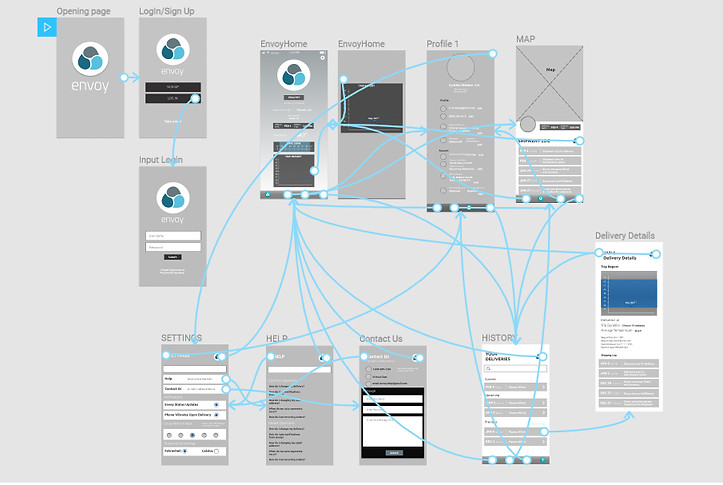
Envoy
Interactive Temperature Regulated Shipping Container and App
Intravenous Immunoglobulin is an infusion of antibodies from over 1,000 blood donors, needed by more than 8.5 million immune-deficient patients in the U.S. every month. Approximately 20%(1.7 million) of these patients have the IVIG shipped to and administered in their home. Currently, it is estimated that five to ten percent of the 41 million grams of Intravenous immunoglobulin shipped in the U.S. arrives unusable or doesn’t arrive at all. Envoy is a cost effective and efficient shipping container designed and engineered to keep bio-products at a regulated temperature during transit. The accompanying app provides peace of mind with constant flow of information regarding shipment and delivery of this life-preserving and very expensive bio-product.
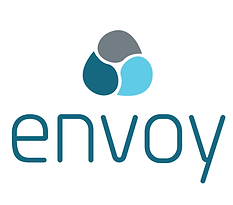



PRODUCT SYSTEM
PHYSICAL PRODUCTS
The physical shipping container was intended to be sturdy with limited sharp edges so the product would stand the test of time. The sides are drafted and curved so it would be easy to handle by shippers and patients alike. The container aesthetic was intended to be inviting with orange fields and blue fields used to identify manual contact.
USER EXPERIENCE

Customer or distributor places an order online or over the phone for the shipping service.
Shippers power on Envoy to initiate diagnostic test and a satisfactory status will initiate shipment.
During transit, Envoy periodically tests the temperature of the product.
User (patient/distributor)
can text Envoy or check
app for the overall status and projected delivery time.
Shipper delivers Envoy
and patient opens package
to remove product. Envoy
is then return shipped.
Envoy is a customizable service for all types of user groups to insure their rightful delivery of lifesaving products. From shipment to delivery, constant communication of product status is readily available and offers additional security. Therefore, the user knows when their product will arrive and feel reassured in the timing of their medical treatment.
TECHNOLOGY

The peltier module regulates the temperature of the health product by transmitting the temperature from dry ice or a heat packet over an extended period of time. Temperature is regulated from 5-7 days.
Light is passed through medical
product. The receiver will be able
to read whether the product has
changed in appearance.



APP DESIGN
Envoy Management
Envoy's home screen and profile pages were designed to quickly provide the status of their Envoy shipment both informationally and aesthetically. The background color wash will adjust to show the current status of the shipment so the user knows immediately how their shipment is fairing and in the rare event if their shipment has been compromised. Personalization is added through engaging a regional background mode that displays images related to the user's location sourced from a database.
Color wash
reveals status
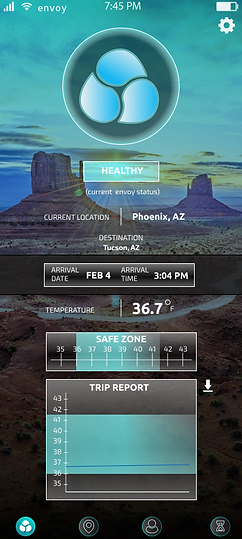




Adjust and personalize profile
Set backgrounds to regional for a personalized look
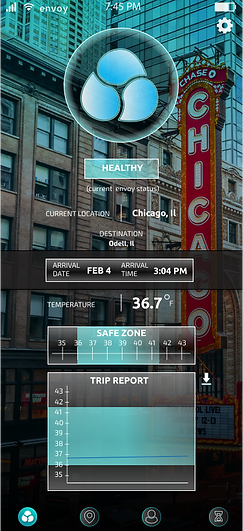



Shipment Details
Get active feedback regarding shipment details with real time updates and an easy to access shipment log. Shipment history is a way for users to check previous, current, and future shipment details.

Track shipment and monitor progress on the map
Review previous and current trip reports


Get notifications of
envoy arrival and status


Adjust Settings and Get Help
As Envoy is a service intended for high priced healthcare products that people rely on for their personal health, attention was paid to including customer service interactions within the app. Customers would also be able to access a full help menu with common questions being addressed in order to relay trust and accessibility.




Interactive Prototype

DISCOVERY
JUSTIFICATION
IVIG is only one of several specialty pharmacy blood products that are expensive, temperature sensitive, and often lost or damaged. A total estimated $200 - $400 million worth of temperature-sensitive specialty pharmacy products are lost or damaged in transport… per year. Since an average unit of IVIG (~55 grams) can cost $4,400 (and up to $10,000+), this represents a significant problem not yet properly addressed. The following list identifies shipping concerns.
1) Environments change (shipping blood products to Tucson in July will have a smaller temperature allowance window than it would in December).
2) Shippers don’t know which containers are in danger of going bad.
3) Despite their high market value ($1,000 - $100,000; average of $5,000), there is no way to track lost or stolen blood products.
4) Ice packs provide a very small window
of shipping time.
PROBLEM IDENTIFICATION

Due to the increased need in mobile health care, common areas of interest were first mapped for problem inspiration. The interconnection between home care and rural communities narrowed the topic and focus population.


USER PROFILES

Healthcare Provider
There are three types of organizations whose nurses directly administer the specialty pharmaceutical blood products to the patient in their home pharmacies (ex: CVS), home health care companies (ex: Accredo), Hemophilia Treatment Centers (HTC’s), and hospital systems (ex: Banner Health). In the home setting, HTC’s and home health care companies are the overriding major industry player.

Distributor
There are several main distributors of IVIG, factor, and A1AT infusion therapy products, such as BioCare,
Novo Nordisk, and McKesson. These companies are the middlemen between manufacturers and health
providers and are located regionally around the country.

Patient or Consumer
In the U.S., there are three main consumers of Valuable temperature sensitive specialty pharmaceutical blood products in the home:
- 18,600 hemophiliacs
- 1.7 million immune-deficient people
- 5,000 people suffering from Alpha 1 Antitrypsin deficiency (a type of congenital emphysema that has no cure short of a lung transplant). These patients are told to wait an average of eight hours in their home, to sign for the shipment.

Shipper
Health providers commonly use the UPS Cold Chain Solution service to ship the blood products individually to its patients’ homes. Average
packages are valued at $10,000 for IVIG and $30,000 to $300,000 for factor. The health providers and distributors we interviewed cited shippers’ human errors as the most common cause for damaged product. A strength of FedEx that is a weakness of UPS is its shipping transparency (distributors can communicate with driver).
CASE STUDY
NAME: Julia Warren
AGE: 57
CONDITION: Myasthenia Gravis
LOCATION: Pullman, WA
REASON FOR PLASMA: Lowered immune system. Plasma helps with energy and reduces contracted illnesses.
CUSTOMER HISTORY: Ten years
NOTABLE QUOTES AND STORIES:
"If it doesn't arrive at the right temperature, whether too cold or too hot, it will make me sick."
"I was getting some shipments from Arizona from the label I was showing all the way to the Pullman WA and that is a huge temperature difference and distance. They would just leave it there on my door and every shipment was costing my insurance $3,000.00. Sometimes it would go bad in the sun on the way to me, not even left on my doorstep. It would already be ruined even when it was delivered into my hands.I would have to call them up and say guys "this is ruined and I need a new shipment" and they would have to overnight it and it would delay the treatment. Then, it was twice the expense for the medication."
"There was a period of five or six years where at least once in spring and once or twice in summer I would have to have a new order. One time in particular, I opened it up and it exploded. It was like glue, it was bad and it smelled really bad. Dead blood and slime...it was horrible and rank."


IDEATION
PHYSICAL PRODUCT SYSTEM
I tend to sketch out my ideas over several sketch pages while trying to address potential functionality as well as aesthetics. The end design was kept simple to aid with stacking, shipment, and the overall clean branding feel. Although many of the sketches look nothing like the end design, it helps me address the problem as a whole, explore and expand ideas, and is a way to process general concerns and styling potential.
FUNCTION TREE
This technique is used to assist narrowing topics for development. Similar to mind-mapping, it is a visual representation of the main functionality concerns that need to be considered during the production of the final design. I personally used this diagram throughout both the product and app development to ensure I addressed every point of the human/product interaction.


MF & HF PROTOTYPING
Figma is great for working out functional kinks before fully committing to a design. With their component feature I am able to make a quick MF prototype and then later update their component attributes during the design phase. I am also able to move boards around so that I can clearly see where each interaction will lead me and actively test the design at any stage with their prototyping features.
